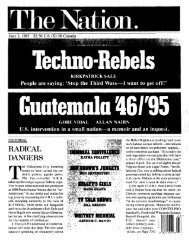Divergent Trajectories: Healthcare Insurance Reforms in East Asia ...
Divergent Trajectories: Healthcare Insurance Reforms in East Asia ...
Divergent Trajectories: Healthcare Insurance Reforms in East Asia ...
Create successful ePaper yourself
Turn your PDF publications into a flip-book with our unique Google optimized e-Paper software.
Illan Nam, Colgate University, Feb 2011Draft <strong>in</strong> progress, please do not quote or citerole that cross-class coalitions between formal and <strong>in</strong>formal sector workers played as wellas the effects of party system <strong>in</strong>stitutionalization <strong>in</strong> shap<strong>in</strong>g electoral competition toexpla<strong>in</strong> the divergent healthcare reform outcomes we f<strong>in</strong>d <strong>in</strong> develop<strong>in</strong>g democracies.S<strong>in</strong>ce the 1990s, deepened <strong>in</strong>tegration <strong>in</strong>to world trade and capital markets hasbeen accompanied by grow<strong>in</strong>g labor market <strong>in</strong>security for both formal and <strong>in</strong>formalsector workers. Along with greater openness, countries <strong>in</strong> Lat<strong>in</strong> America and <strong>East</strong> <strong>Asia</strong>implemented changes to labor market regulations that produced ris<strong>in</strong>g labor marketprecariousness dur<strong>in</strong>g the 1990s and beyond. Neoliberal reforms <strong>in</strong> Lat<strong>in</strong> Americasubstantially reduced the density and breadth of labor organizations and led to theattrition of formal-sector workers (Murillo, Roberts). Reform and downsiz<strong>in</strong>g of thepublic sector eroded the liv<strong>in</strong>g standards and size of middle class workers that this sectorhad created dur<strong>in</strong>g the import-substitution era. In <strong>East</strong> <strong>Asia</strong>, too, globalization <strong>in</strong>troducedsignificant pressures upon the work<strong>in</strong>g and middle classes. A surpris<strong>in</strong>g feature of <strong>East</strong><strong>Asia</strong>n labor markets is that, although developmental policies created a large and vibrantclass of skilled and white-collar workers, many of these workers nonetheless belonged tothe “irregular” sector, as they were either self-employed or contract workers. These“irregular” employees accounted for more than a third of the active work<strong>in</strong>g populationdur<strong>in</strong>g the 1980s, and their share rose even higher dur<strong>in</strong>g the 1990s and 2000s.Yet, while workers across both regions experienced more <strong>in</strong>security <strong>in</strong> the termsand status of their employment, the policy response to compensat<strong>in</strong>g workers has beenquite varied, as has already been recounted. In South Korea, the policy response was topush for a reform that <strong>in</strong>creased redistribution between formal and <strong>in</strong>formal sectorworkers, and <strong>in</strong> particular, between upper-<strong>in</strong>come and lower-<strong>in</strong>come workers. In Chile,25













